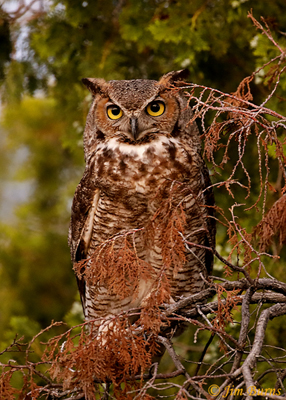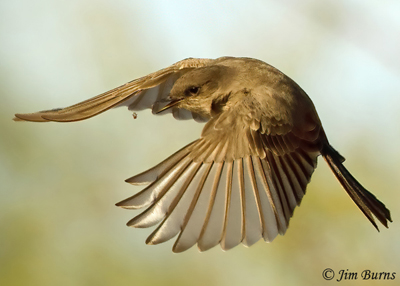
February 23—On what would become our first and last birding trip out of state last year, I realized a long standing goal of photographing both Western and Clark’s Grebes “rushing,” a spectacular courtship behavior by pairs (both male-male and male-female) in which they lunge forward, bodies out of the water, and run across the surface together, wings uplifted. Lake Hodges in SoCal is the best, closest site.
April 23—After years of hearing, but never seeing, the Great Horned Owls on the Scottsdale Greenbelt one block from our house, one of the territorial pair inexplicably appeared at dusk in a tree in our yard. Can you say “unexpected new yard bird!”
May 13—Indigo Bunting is not an easy species to find in Arizona. Imagine my surprise to find and photograph a singing male hanging out along a riparian area on the Tonto National Forest just north of Phoenix.
May 15—Just two days later as I sloshed down the same stream, a Yellow-breasted Chat popped up on a snag and challenged my presence with its full repertoire of odd vocalizations, a stunning display from a typically elusive and reclusive species.
August 15—On a hike in the White Mountains I just missed seeing an American Three-toed Woodpecker, but found and photographed it the next day in the very same tree two miles from my campsite. The odds of this occurring seemed far less than even finding this uncommon species on a stake-out. Thank you Mary McSparen.
August 22—For the third time in three different years I found an uncommon Hooded Warbler (male) coming to a mountain spring on the Tonto National Forest, leading me to suspect breeding in the area. You can be sure I’ll check it out again next summer.
September 16—As most of us did, I saw and photographed the male Canada Warbler, very much out of his expected migratory pathway, which fattened up on insects for several days at the Gilbert Riparian Area.
October 29—Continuing the unprecedented influx of Eastern warblers found in Arizona last fall, the Black-throated Blue Warbler male that delighted so many area birders at the Gilbert Riparian Area came and sat beside me on a mesquite branch one afternoon, close enough for a picture with my cell phone! On my birthday! I am not making this up.
November 18—Having spent one morning along the Salt River with both Black and Say’s Phoebes without checking the back of my camera, I was astonished to discover on my computer screen back home that I had actually captured both species capturing insects in flight.
December 24—What does one do for excitement on Christmas Eve during a pandemic featuring social distancing? Well, I discovered a roost of Long-eared Owls on the Tonto. This species made this list last year, but these were at a different site. What makes for a better Christmas present than a birder unexpectedly finding owls?
So, even without bird travel in a year of pandemic low points, 2020 provided several birding high points, unanticipated, unimagined, coincidental, very lucky high points. This is why we bird. This is why the wonder of the avian world never ends. This is why we look forward to 2021, even though our lives will never be normal again.